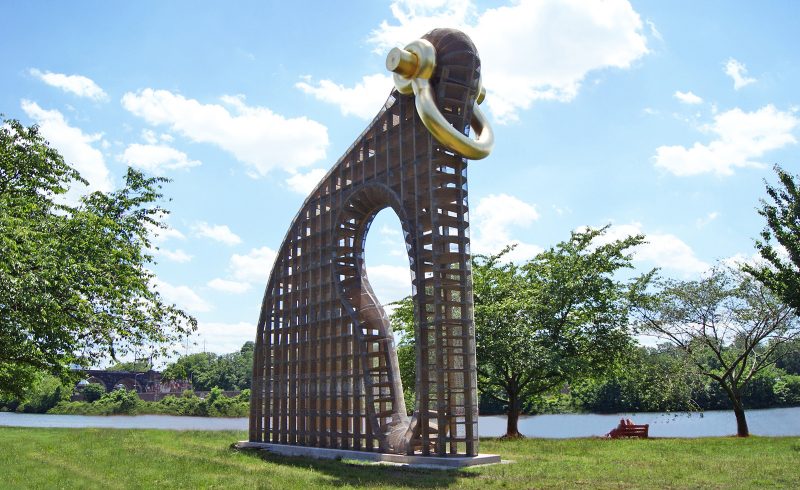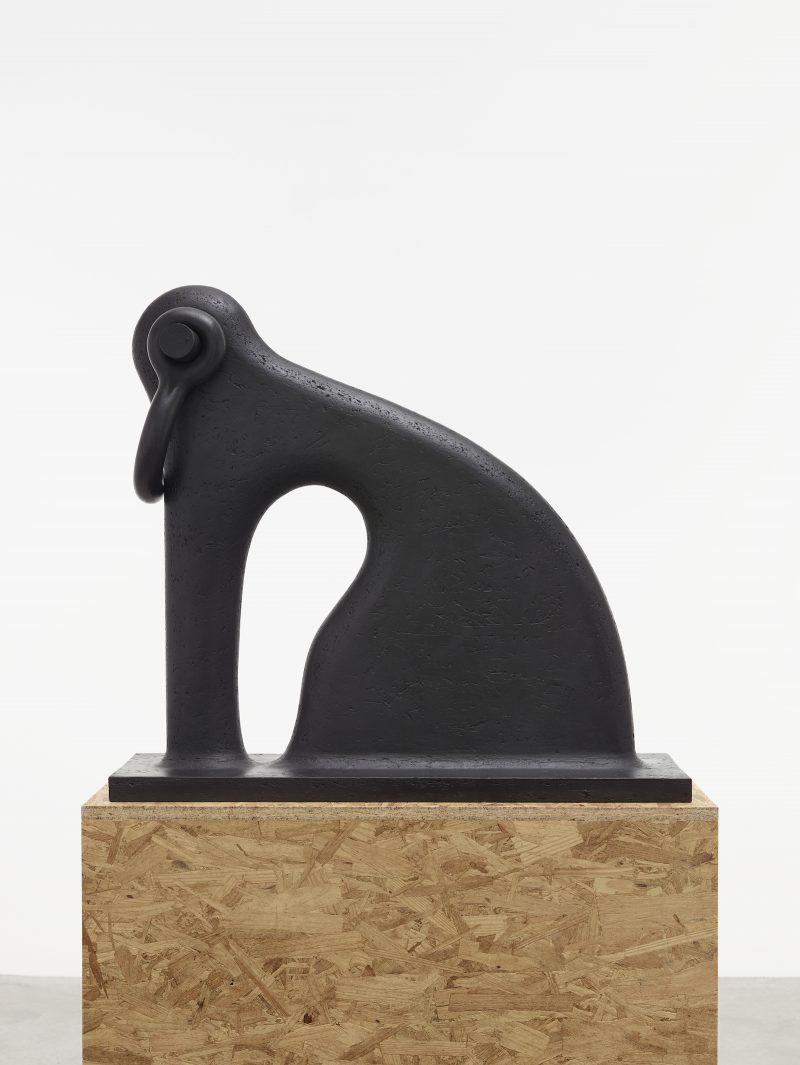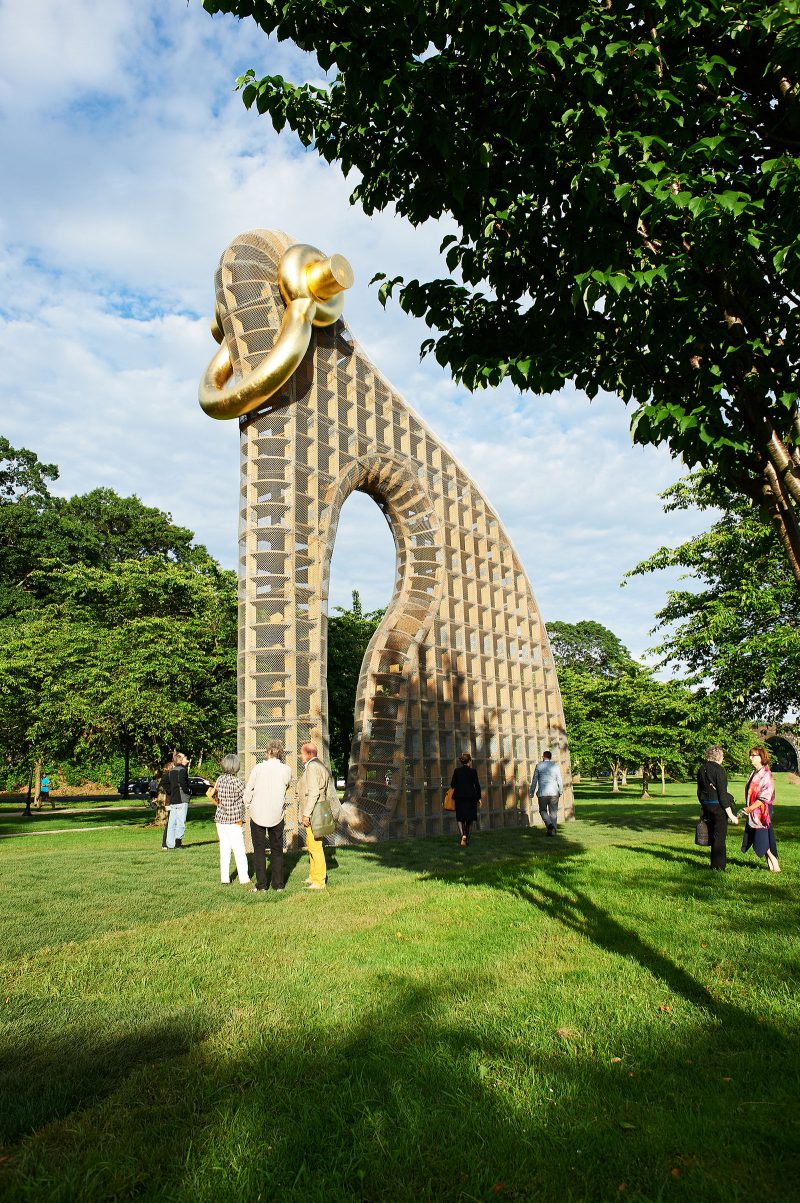Part animal, part abstraction, and part intellectual meditation
“My work has a potential for evolution, change, and open-endedness, which to me feels resonant with what it is to live a life.” – Martin Puryear

If you’ve recently traveled on Kelly Drive or the Schuylkill Expressway, or on the Schuylkill River path up past Boathouse Row, you may have been surprised by Martin Puryear’s colossal, not quite figurative, sculpture, Big Bling, which the artist has described as part animal, part abstraction, and part intellectual meditation.
Big Bling, made of plywood and wire mesh, with a magnificent accent of gold, lives up to her name. She stands a towering forty feet tall – although she looks taller than that — and thirty-eight feet long. Yet she’s a skinny ten feet wide. To get a good look at her, you must stand back quite a way. As for Bling, a term of Jamaican slang originally referring to the sound generated by flashy jewelry and accessories, and later referring generally to conspicuous materialism, the sculpture’s golden headpiece may bring to mind an ostentatious mouthpiece or a nose ring.
Big Bling’s infrastructure of plywood covered with wire mesh makes her a transparent creature and, as intended by the artist, she invites an observer’s speculation and free association. When I asked passers-by for their impressions, one thought the sculpture was elephantine, another thought it looked like Kardashian stilettos, and yet to another it appeared as the shape of a sprinter braced at her blocks. Although Big Bling’s prominent gold accessory has been described by commentators and promoters as a shackle, and the sculpture is closely related to Puryear’s earlier work entitled Shackled, it did not strike casual observers as such.
Big Bling’s Progenitor: Shackled

© Martin Puryear, Courtesy Matthew Marks Gallery
Martin Puryear’s 2014 Shackled is a solid black iron sculpture of the same overall shape and contours as Big Bling, but which is only 27.5 inches tall. The piece is severe and foreboding, and, I think, unlike Big Bling, its shackle directly invokes the shackles of slavery and slave trade. Indeed, I understand that Shackled is part of a series of Puryear’s works which are variations upon the shape of the Phrygian cap (the “liberty cap”), which was a symbol of resistance during the French Revolution and may have also related to the temporary abolition of slavery in France and its colonies as a result of the revolution.
The combination of the wire mesh integument — a kind of fence for a skin — and the constraining function of the shackle, which does look like a horse bit, suggests restraints upon innate power. On the other hand, with its static and rooted pose, Big Bling is a gentle creature. Actually a gentle creature flawed by its shackle. Flawed, because the shackle adds dissonance to a sculpture which otherwise seems disinterested in a narrative such as the one suggested by Shackled.
Perhaps the artist intended this level of dissonance to highlight the staining effects of avarice upon our souls. Perhaps not. In any event, to my mind the shackle spoils – I want my gentle giant back. I want her unrestrained.
Whether you find Big Bling pleasing or not, whether you find it provocative or not, I would argue that the proliferation of public art like this in our city is hugely enriching. It serves as a counterbalance to the intrusive signposts of commerce that surrounded us. It also serves as a reminder that our creative sensibilities run deep. Thanks, Association for Public Art (APA), for functioning as the steward of such public art in the city now for 145 years.

More about the artist and the work
Martin Puryear, is a highly acclaimed artist known (although not as well-known as he should be) for his sculpture and works on paper. Educated at Catholic University, the Royal Swedish Academy of Arts, and Yale University, Puryear received a Guggenheim Fellowship in 1982, a MacArthur Foundation Fellowship in 1989, the Gold Medal in Sculpture from the American Academy of Arts and Letters in 2007, and the National Medal of Arts in 2011, and he has exhibited his work worldwide. In the 1960s, he served in the Peace Corps in West Africa.
Big Bling was born in Madison Square Park, in New York City, near the famed Flatiron Building. It was commissioned by the Madison Square Park Conservancy, and it is being presented here in Philadelphia pursuant to a collaboration between that organization and the aPA. Although I’m not sure why, the sculpture apparently was intended by Mr. Puryear to be a temporary public art work, which I assume means that it will be dismantled at some point after its residency here.
Big Bling is Martin Puryear’s second major contribution to public art in Philadelphia. His tree house-like Pavilion in the Trees was installed at the Horticulture Center in Fairmount Park in 1993. Beginning September 8th, The Print Center will be putting on an exhibition of Puryear’s prints.
Big Bling stands on the east bank of the river between Fountain Green Drive and the Connecting Railway and Girard Avenue Bridges (see map), and will be there through November. By the way, Thomas Eakins set up his easel on the same site in 1871 when he painted “Max Schmitt in a Single Scull.”









